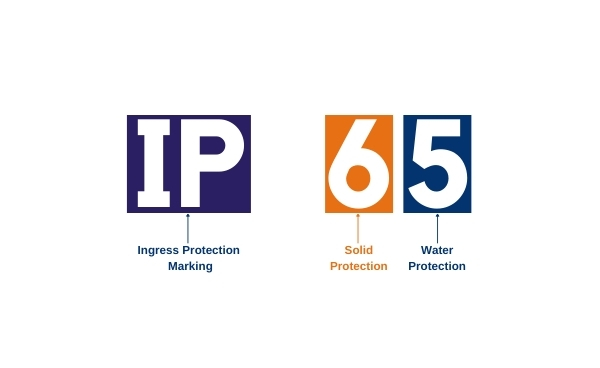How do IP protection ratings work?
How do Ingress Protection ratings (IP) work?
IP Protection ratings are based on two numbered codes that define the exact degree of protection.
- The first digit is resistance to solids.
- The second digit is resistance to liquids.
All these protection ratings therefore take the form of “IP” followed by two digits. Generally speaking, the higher the number, the greater the protection against small solids and the better the seal.

IP rating first digit: resistance to solids (0-6)
The first digit following “IP” refers to the device’s ability to withstand solid objects:
- 0 = Zero means that there is no protection against penetration of solid particles, objects, or dust.
- 1 = The object or equipment is protected against any solid object larger than 50 mm.
- 2 = The object or equipment is protected against any solid object larger than 12.5 mm.
- 3 = The object or equipment is protected against any solid element larger than 2.5 mm. This would apply, for example, if a user attempted to insert fine tools, cutting objects, etc.
- 4 = The object or equipment is protected against any solid object larger than 1 mm, i.e. other types of tools or even screws.
- 5 = This protection rating indicates that the object is partially protected against dust. In other words, dust can enter crevices of the equipment but cannot damage the equipment. It also ensures that contact is not possible.
- 6 = In this case, the product is completely dust proof. Dust cannot enter the crevices and therefore cannot damage or soil it internally under any circumstances.
IP rating second digit: resistance to liquids (0-8)
The IP protection against liquids concerns both the amount of water and the depth of immersion or even the power of a jet.
- 0 = Zero here means that there is no protection against moisture or any liquid that would come into contact with the device or object.
- 1 = This indicates that the object is protected against liquid falling vertically only.
- 2 = The object is protected against drops falling at 15 degrees.
- 3 = In this case, the object is protected against liquid sprays in all directions, provided that they do not exceed 60 degrees.
- 4 = The object is protected against splashing.
- 5 = This rating guarantees the protection of the device against water projections.
- 6 = The object is protected against powerful water jets, for example with a high-pressure cleaning device.
- 7 = In this case, the object is waterproof up to a depth of 1 m.
- 8 = The object is waterproof beyond a depth of 1 m. Although water can seep into the equipment, it cannot damage the equipment.
- How do you troubleshoot 3 phase AC motor?
 The table presented below provides a comprehensive insight into the…
The table presented below provides a comprehensive insight into the… - Types of losses in Induction Motor
 The losses in induction motor are broadly categorized into two…
The losses in induction motor are broadly categorized into two… - 5 Symptoms Of Failing Electric Motor Rotor
 Motors are used everywhere in industrial environments and they are…
Motors are used everywhere in industrial environments and they are… - Comparison between servo motor vs induction motor
 The Technological lines separating induction motors from servo motors are…
The Technological lines separating induction motors from servo motors are… - Comparison between Electromagnetic Flowmeter and Ultrasonic Flowmeter
 Water and wastewater Expert depends on accurate flow measurements for…
Water and wastewater Expert depends on accurate flow measurements for… - How do IP protection ratings work?
 How do Ingress Protection ratings (IP) work? IP Protection ratings…
How do Ingress Protection ratings (IP) work? IP Protection ratings…

